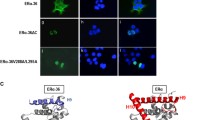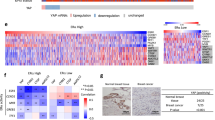Abstract
To investigate a presumed crosstalk between estrogen receptor α (ERα) and the TGF-β signaling pathway in breast cancer, we analyzed the TGF-β-induced expression of the plasminogen activator inhibitor 1 (PAI-1) gene in ER-positive MCF-7 cells. After siRNA-mediated knock-down of endogenous ERα, the transcription level of PAI-1 was upregulated, pointing to an attenuation of TGF-β signaling by the presence of ERα. We verified these findings by a vice versa approach using a primary ER-negative cell model transiently overexpressing either ERα or ERβ. We found that ERα, but not ERβ, led to a strong inhibition of the TGF-β1 signal, monitored by TGF-β reporter assays. This attenuation was completely independent of receptor stimulation by β-estradiol (E2) or inhibition by the pure antagonist ICI 182.780 (ICI). Our results indicate a permanent repression of PAI-1 by ERα and suggest a ligand-independent crosstalk between ERα and TGF-β signaling in breast cancer cells.






Similar content being viewed by others
References
Harris L, Fritsche H, Mennel R et al (2007) American society of clinical oncology 2007 update of recommendations for the use of tumor markers in breast cancer. J Clin Oncol 25:5287–5312. doi:10.1200/JCO.2007.14.2364
Knight WA, Livingston RB, Gregory EJ et al (1977) Estrogen receptor as an independent prognostic factor for early recurrence in breast cancer. Cancer Res 37:4669–4671
Matthews J, Gustafsson J-A (2003) Estrogen signaling: a subtle balance between ERα and ERβ. Mol Interv 3:281–292. doi:10.1124/mi.3.5.281
Nilsson S, Mäkelä S, Treuter E et al (2001) Mechansim of estrogen action. Physiol Rev 81:1535–1565
Hawse JR, Subramaniam M, Ingle JN et al (2008) Estrogen-TGFβ cross-talk in bone and other cell types: role of TIEG, Runx2, and other transcription factors. J Cell Biochem 106:383–392. doi:10.1002/jcb.21425
Knabbe C, Lippman ME, Wakefield LM et al (1987) Evidence that transforming growth factor-β is a hormonally regulated negative growth factor in human breast cancer cells. Cell 48:417–428. doi:10.1016/0092-8674(87)90193-0
Roberts AB, Wakefield LM (2003) The two faces of transforming growth factor β in carcinogenesis. Proc Natl Acad Sci USA 100:8621–8623. doi:10.1073/pnas.1633291100
Kaminska B, Wesolowska A, Danilkiewicz M (2005) TGF beta signalling and its role in tumor pathogenesis. Acta Biochim Pol 52:329–337
Westerhausen DR, Hopkins WE, Billadello JJ (1991) Multiple transforming growth factor-β-inducible elements regulate expression of the plaminogen activator inhibitor type-1 gene in Hep G2 cells. J Biol Chem 266:1092–1100
Dickson RB, Kasid A, Huff KK et al (1987) Activation of growth factor secretion in tumorigenic states of breast cancer induced by 17β-estradiol or v-Ha-ras oncogene. Proc Natl Acad Sci USA 84:837–841. doi:10.1073/pnas.84.3.837
Buck MB, von der Fecht J, Knabbe C (2002) Antiestrogenic regulation of transforming growth factor beta receptor I and II in human breast cancer cells. Ann N Y Acad Sci 963:140–143
Brandt S, Kopp A, Grage B et al (2003) Effects of tamoxifen on transcriptional level of transforming growth factor beta (TGF-beta) isoforms 1 and 2 in tumor tissue during primary treatment of patients with breast cancer. Anticancer Res 23:223–229
Buck MB, Pfizenmaier K, Knabbe C (2004) Antiestrogens induce growth inhibition by sequential activation of p38 mitogen-activated protein kinase and transforming growth factor-β pathway in human breast cancer. Mol Endocrinol 18:1643–1657. doi:10.1210/me.2003-0278
Buck MB, Fritz P, Dippon J et al (2004) Prognostic significance of transforming growth factor β receptor II in estrogene receptor-negative breast cancer patients. Clin Cancer Res 10:491–498. doi:10.1158/1078-0432.CCR-0320-03
Rae JM, Creighton CJ, Meck JM et al (2007) MDA-MB-435 cells are derived from M14 melanoma cells—a loss for breast cancer, but a boon for melanoma research. Breast Cancer Res Treat 104:13–19. doi:10.1007/s10549-006-9392-8
Berthois Y, Katzenellenbogen JA, Katzenellenbogen BS (1986) Phenol red in tissue cultur media is a weak estrogen: implications concerning the study of estrogen-responsive cells in culture. Proc Natl Acad Sci USA 83:2496–2500. doi:10.1073/pnas.83.8.2496
Wrana JL, Attisano L, Carcamo J et al (1992) TGFβ signals through a heteromeric protein kinase complex. Cell 71:1003–1014. doi:10.1016/0092-8674(92)90395-S
Dai JL, Turnacioglu KK, Schutte M et al (1998) Dpc4 transcriptional activation and dysfunction in cancer cells. Cancer Res 58:4592–4597
Andersson S, Davis DL, Dahlbäck H et al (1989) Cloning, structure, and expression of the mitochondrial cytochrome P-450 sterol 26-hydroxylase, a bile acid biosynthetic enzyme. J Biol Chem 264:8222–8229
Lai C-F, Feng X, Nishimura R et al (2000) Transforming growth factor-β up-regulates the β5 integrin subunit expression via Sp1 and Smad signaling. J Biol Chem 275:36400–36406. doi:10.1074/jbc.M002131200
Edwards DR, Murphy G, Reynolds JJ et al (1987) Transforming growth factor beta modulates the expression of collagenase and metalloproteinase inhibtor. EMBO J 6:1899–1904
Massague J, Wotton D (2000) Transcriptional control by the TGF-β/Smad signaling system. EMBO J 19:1745–1754. doi:10.1093/emboj/19.8.1745
Hall M-C, Young DA, Waters JG et al (2003) The comparative role of activator protein 1 and Smad factors in the regulation of Timp-1 and MMP-1 gene expression by transforming growth factor-β1. J Biol Chem 278:10304–10313. doi:10.1074/jbc.M212334200
Revillion F, Pawlowski V, Hornez L et al (2000) Glyceraldehyde-3-phosphate dehydrogenase gene expression in human breast cancer. Eur J Cancer 36:1038–1042. doi:10.1016/S0959-8049(00)00051-4
Van der Burg B, Van Selm-Miltenburg AJ, Laat SWD et al (1989) Direct effects of estrogen on c-fos and c-myc protooncogene expression and cellular proliferation in human breast cancer cells. Mol Cell Endocrinol 64:223–228. doi:10.1016/0303-7207(89)90149-4
Müller V, Jensen EV, Knabbe C (1998) Partial antagonism between steroidal and nonsteroidal antiestrogens in human breast cancer cell lines. Cancer Res 58:263–267
Wakeling AE, Dukes M, Bowler J (1991) A potent specific pure antiestrogen with clinical potential. Cancer Res 51:3867–3873
Brünner N, Frandsen TL, Holst-Hansen C et al (1993) MCF7/LCC2: a 4-hydroxytamoxifen resistant human breast cancer variant that retains sensitivity to the steroidal antoestrogen ICI 182;780. Cancer Res 53:3229–3232
Burdette JE, Woodruff TK (2007) Activin and estrogen crosstalk regulates transcription in human breast cancer cells. Endocr Relat Cancer 14:679–689. doi:10.1677/ERC-07-0054
Qi X, Borowicz S, Pramanik R et al (2004) Estrogen receptor inhibits c-jun-dependent stress-induced cell death by binding and modifying c-jun activity in human breast cancer cells. J Biol Chem 279:6769–6777. doi:10.1074/jbc.M311492200
Teyssier C, Belguise K, Galtier F et al (2001) Characterization of the physical interaction between estrogen receptor α and JUN proteins. J Biol Chem 276:36361–36369. doi:10.1074/jbc.M101806200
Matsuda T, Yamamoto T, Muraguchi A et al (2001) Cross-talk between transforming growth factor-β and estrogen receptor signaling through Smad3. J Biol Chem 276:42908–42914. doi:10.1074/jbc.M105316200
Wu L, Wu Y, Gathings B et al (2003) Smad4 as a transcription corepressor for estrogen receptor α. J Biol Chem 278:15192–15200. doi:10.1074/jbc.M212332200
Green KA, Carroll JS (2007) Oestrogen-receptor-mediated transcription and the influence of co-factors and chromatin state. Natl Rev 7:713–722
Foekens JA, Schmitt M, van Putten WL et al (1994) Plasminogen activator inhibitor-1 and prognosis on primary breast cancer. J Clin Oncol 12:1648–1658
Tian F, Byfield SD, Parks WT et al (2003) Reduction in Smad2/3 signaling enhances tumorigenesis but supresses metastasis of breast cancer cell lines. Cancer Res 63:8284–8292
Jänicke F, Schmitt M, Pache L et al (1993) Urokinase (uPA) and its inhibitor PAI-1 are strong and independent prognostic factors in node-negative breast cancer. Breast Cancer Res Treat 24:195–208. doi:10.1007/BF01833260
Roberts AB, Tian F, Byfield SD et al (2006) Smad3 is key to TGF-β-mediated epithelial-to-mesenchymal transition, fibrosis, tumor supression and metastasis. Cytokine Growth Factor Rev 17:19–27. doi:10.1016/j.cytogfr.2005.09.008
Bover L, Barrio M, Bravo AI et al (1998) The human breast cancer cell line IIB-BR-G has amplified c-myc and c-fos oncogenes in vitro and is spontaneously metastatic in vivo. Cell Mol Biol (Noisy-le-grand) 44:493–504
Rich MA, Furmanski P, Brooks SC (1978) Prognostic value of estrogen receptor determinations in patients with breast cancer. Cancer Res 38:4296–4298
Foekens JA, Look MP, Peters HA et al (1995) Urokinase-type plasminogen activator and its inhibitor PAI-1: predictors of poor response to tamoxifen therapy in recurrent breast cancer. J Natl Cancer Inst 87:751–756. doi:10.1093/jnci/87.10.751
Han B, Nakamura M, Mori I et al (2005) Urokinase-type plasminogen activator system and breast cancer. Oncol Rep 14:105–112 review
Harrell JC, Dye WW, Allred DC et al (2006) Estrogen receptor positive breast cancer metastasis: altered hormonal sensitivity and tumor aggressiveness in lymphatic vessels and lymph nodes. Cancer Res 66:9308–9315. doi:10.1158/0008-5472.CAN-06-1769
Odekon LE, Blasi F, Rifkin DB (1994) Requirement for receptor-bound urokinase in plasmin-dependent cellular conversion of latent TGF-β to TGF-β. J Cell Physiol 158:398–407. doi:10.1002/jcp.1041580303
Delany AM, Canalis E (2001) The metastasis-associated metalloproteinase stromelysin-3 is induced by transforming growth factor-β in osteoblasts and fibroblasts. Endocrinology 142:1561–1566. doi:10.1210/en.142.4.1561
Acknowledgments
This work was supported by grants from the Robert Bosch Foundation.
Author information
Authors and Affiliations
Corresponding author
Rights and permissions
About this article
Cite this article
Stope, M.B., Popp, S.L., Knabbe, C. et al. Estrogen receptor α attenuates transforming growth factor-β signaling in breast cancer cells independent from agonistic and antagonistic ligands. Breast Cancer Res Treat 120, 357–367 (2010). https://doi.org/10.1007/s10549-009-0393-2
Received:
Accepted:
Published:
Issue Date:
DOI: https://doi.org/10.1007/s10549-009-0393-2




